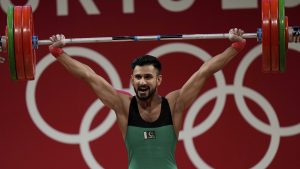Pakistani weightlifter Talha Talib may have missed out on a rare Olympic medal as he debuted for Pakistan in the Tokyo 2020 games Sunday, but he turned heads in South Asia.
The 21-year-old entered the competition without a coach, supported only by family and friends after training in a makeshift gym without standard Olympic-level equipment. The athlete from Gujranwala, known as the “city of wrestlers,” held the gold medal spot in the 67 kilogram category until the final round.
In the end, he finished fifth.
A dream of every athlete, the Olympics are considered the pinnacle for sports. Competing at the games is proof that you are among the best, and winning gold confirms that you are the best among the best.
The Olympics are more than just a competition between athletes; it pits countries against each other, becoming a matter of national pride globally. But not so much in South Asia.
With three of the world’s 10 most populated countries in South Asia, the region is home to over 1.8 billion people. But to date, it has gathered only 42 medals, shared between Afghanistan, India, Pakistan, and Sri Lanka. Bangladesh, Bhutan, Nepal, and the Maldives have won none.
There are many reasons for South Asia’s medal deficiency but the most important is that sports has never been a priority for anyone in the region – including the government, athletes, and their families.
Olympians aren’t produced overnight. It’s a long-term commitment backed by economic resources.
If an American amateur swimmer spends a few years prioritizing training over academics and it doesn’t work out, she will still have a good shot at a middle-class life. For her South Asian counterpart, the time spent training means fewer opportunities for future economic stability. Therefore, a career in sports is not considered a viable option.
The reluctance to take a chance to pursue sports is further fueled by nonexistent investment, poor infrastructure, and governments’ inability to promote sports at the grassroot level. Rampant corruption and power struggles among government officials also holds back aspiring athletes.
Simply put: the risk outweighs the prize.
The countries that win the most medals are those that have had more wealth to start with. They are able to provide athletes with better infrastructure and training opportunities. Lower-income countries like India, Pakistan, Afghanistan, Nepal, Sri Lanka, Bhutan, Bangladesh, and the Maldives cannot spend lavishly on sports compared to their richer counterparts.
Consequently, their sports federations are unable to build modernized sports facilities, recruit, train, and educate young talent on exercise and diet, and send them off to competitions abroad.
Both India and Pakistan dominated field hockey until 1976, when the Olympics body switched from natural turf to synthetic – a more expensive pasture – rendering Indian and Pakistani hockey players ill-equipped to play at international events, as their sports federations struggled to build synthetic fields to practice on.
But money alone cannot bring medals, as is evident by the winning performance of some lower-income countries with weak infrastructure. Kenya and Ethiopia produce the fastest long-distance runners while Jamaica dominates in track and field events.
South Asia may comprise of developing countries, but they are far from being deprived. The governments and private sector in India, Pakistan, Sri Lanka, and Bangladesh funnel millions of dollars into one sport – cricket. It enjoys government patronage while other sports such as hockey and football, despite popularity, lack investment and encouragement.
If the playing field is hard for men, female athletes have a bigger mountain to climb.
In 2008, India’s tennis star Sania Mirza withdrew from Bangalore Open to avoid controversies. Pakistan’s best squash player, Maria Toorpakay Wazir, spent years training disguised as a boy in the conservative tribal areas.
So, when players like Talib shine, the entire region cheers them.
Talib’s journey mirrors that of India’s luger Shiva Keshavan, who screwed wheels to the bottom of his sled and practiced on Himalayan roads, overtaking cars and trucks to reach speeds of up to 100km/h because the country lacks luge facilities.
But raw talent and determination can only take these athletes so far. They require financial, physical, and emotional support and encouragement to compete at the international level. To achieve that, the South Asian governments and families will have to modify their understanding of sports from just an extracurricular activity to a ladder to raise their standard of living.

































